Ecosystems Chapter Notes | Science for Grade 7 PDF Download
Introduction
An ecosystem is like a big family where plants, animals, and other tiny living things work together with their surroundings, such as sunlight, water, air, and soil, to live and grow. It includes everything in a place, like a pond, forest, or even a small garden, where living things depend on each other and their environment to survive. In this chapter, we will learn how different ecosystems are made up of living and non-living things, how they interact, and how they form food chains to keep life going.
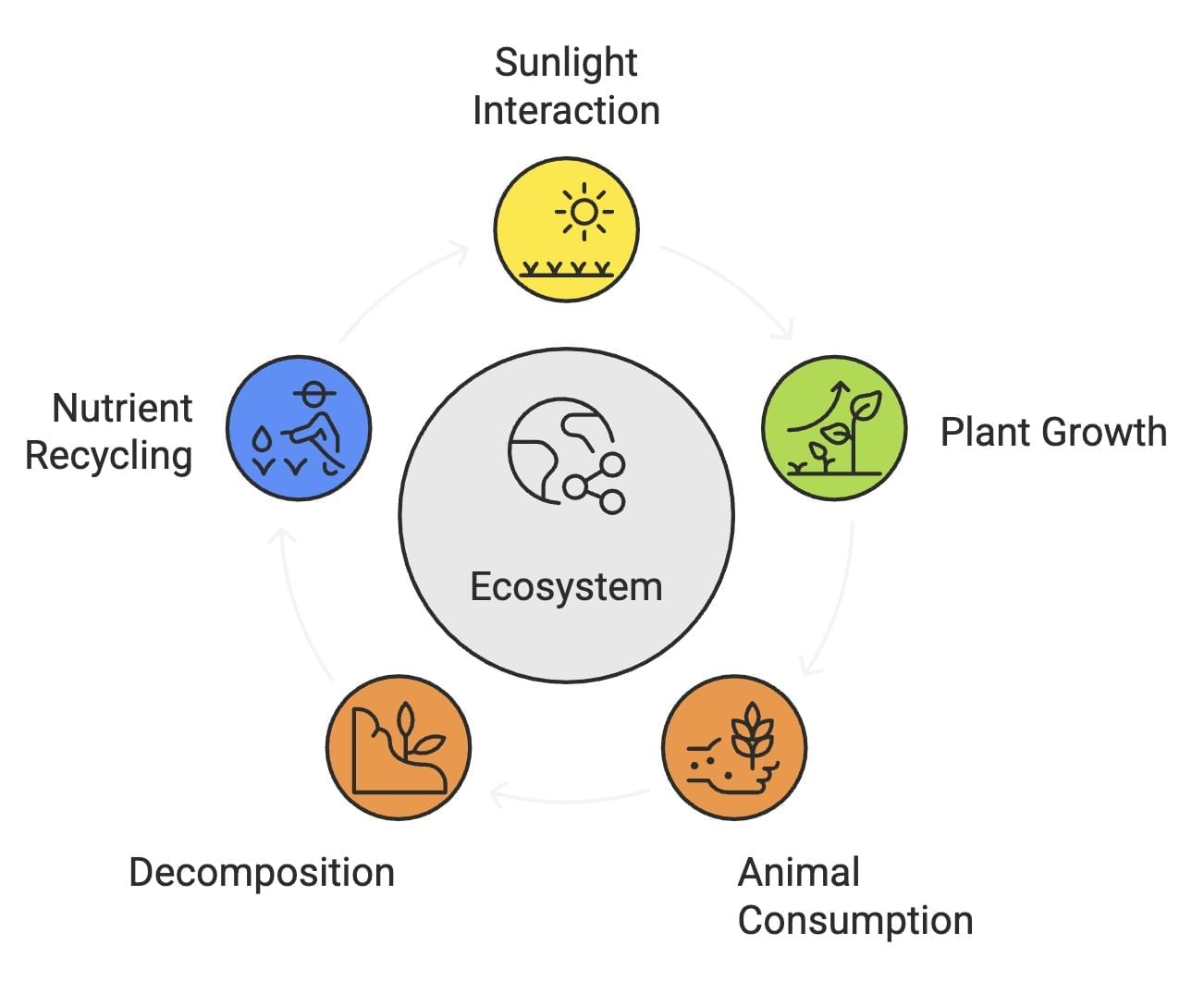
What is an Ecosystem?
- An ecosystem refers to a specific area where all living organisms, including plants, animals, and microorganisms, live together and interact with one another.
- In addition to the living organisms, an ecosystem also comprises non-living components such as sunlight, air, water, soil, and temperature.
- There are different types of ecosystems, including terrestrial (land-based) and aquatic (water-based) ecosystems. Examples of these include ponds, forests, deserts, and even a small garden.
- The living parts of an ecosystem are called biotic components, which consist of plants, animals, and bacteria. On the other hand, the non-living parts are known as abiotic components, which include factors like sunlight, air, water, and soil.
- Within an ecosystem, living organisms constantly interact with one another and with their non-living environment. For instance, in a pond ecosystem, fish eat plants, while plants depend on sunlight to grow. This relationship illustrates the interdependence of different organisms and their environment.
Pond Ecosystem
- A pond is a small body of water that exemplifies an ecosystem.
- It comprises both living and non-living components that interact with one another.
- Non-living elements in a pond encompass water, sunlight, air, and soil at the bottom.
- Living organisms in a pond include plants, fish, duckweed, centipedes, millipedes, various insects, snails, and more.
- Pond plants flourish by utilising sunlight, water, and nutrients from the soil.
- Certain plants, such as water lilies, float on the surface, while others, like algae, grow beneath the water.
- Plants produce their own food through photosynthesis, which requires sunlight, water, and air.
- Animals in the pond, including fish and frogs, consume plants or other small animals.
- Fish feed on tiny plants or insects, while frogs eat insects or small fish.
- Some animals, like snails, feed on the waste of other animals or decaying plants.
- Microscopic bacteria and fungi in the pond break down dead plants and animals into nutrients.
- These nutrients return to the water and soil, supporting the growth of new plants.
- Therefore, a pond ecosystem comprises both living (plants, animals, bacteria) and non-living (water, sunlight, soil).
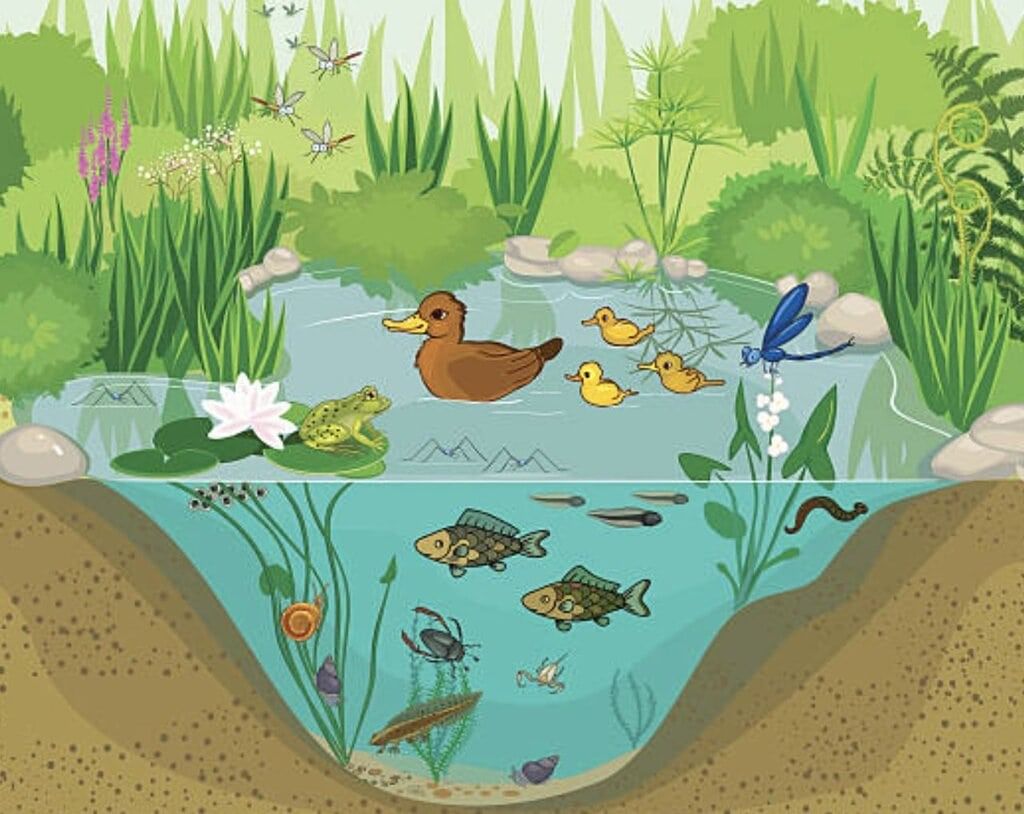
Forest Ecosystem
- A forest is a vast area populated by numerous trees, plants, and animals that coexist.
- It serves as an ecosystem where living organisms and non-living elements interact with one another.
- The non-living components of a forest include sunlight, air, water, soil, and temperature.
- The living parts consist of plants, such as trees, and animals like deer, tigers, and birds, along with tiny organisms.
- Plants, particularly trees, generate their own food through a process called photosynthesis, using sunlight, water, and air.
- Animals in the forest, like deer, eat plants, while predators like tigers hunt animals such as deer.
- Some animals, including birds and squirrels, consume fruits, seeds, or nuts from the plants.
- Tiny organisms such as bacteria and fungi play a crucial role in decomposing dead plants, animals, and leaves, breaking them down into nutrients.
- These nutrients enrich the soil, facilitating the growth of new plants and trees.
- Therefore, a forest ecosystem consists of living beings (like plants, animals, and bacteria) and non-living factors (such as sunlight, soil, and air) that function together in harmony.
In a forest ecosystem, organisms play vital roles:
- Producers (like plants) generate food.
- Consumers (such as deer and tigers) eat plants and other animals.
- Decomposers (like bacteria and fungi) break down dead matter, returning nutrients to the soil.
Components of an Ecosystem
An ecosystem has two main parts: biotic (living) and abiotic (non-living) components.
- Biotic components are the living things, like plants, animals, and tiny organisms.
- Abiotic components are the non-living things like sunlight, air, water, soil, and temperature.
Both biotic and abiotic components work together in an ecosystem to keep it balanced.
1. The Biotic (Living) Components of a Forest Ecosystem
Biotic components are divided into different groups based on their role in the food chain. The food chain is the order in which living things eat each other to get energy.
Trophic Level 1 (Green Plants)
- These are the green plants, bushes, and trees in a forest that make their own food.
- They use sunlight, water, and air to make food through photosynthesis.
- They are called producers because they produce food for the whole ecosystem.
- Examples in a forest are trees, grasses, and small plants.
Trophic Level 2 (Plant-Eating Animals – Herbivores)
- These are animals that eat plants to get their energy.
- They are called primary consumers because they eat the producers (plants).
- Examples in a forest are deer, rabbits, grasshoppers, and squirrels.
- They eat leaves, fruits, seeds, or stems of plants.
Trophic Level 3 (Flesh-Eating Animals – Carnivores)
- These are animals that eat other animals to get their energy.
- They are called secondary consumers because they eat the primary consumers (plant-eating animals).
- Examples in a forest are frogs, snakes, birds, and spiders.
- For example, a frog eats insects, and a snake eats the frog.
Trophic Level 4 (Top Carnivores)
- These are animals that eat other flesh-eating animals.
- They are called tertiary consumers because they are at the top of the food chain.
- Examples in a forest are tigers, lions, and hawks.
- For example, a tiger eats a deer, and a hawk eats a snake.
2. The Abiotic (Non-Living) Components of a Forest Ecosystem
Abiotic components are the non-living things that help living things survive in an ecosystem.
1. Sunlight
- Sunlight gives energy to plants for photosynthesis, which helps them make food.
- It also keeps the forest warm, which is important for animals and plants to live.
2. Air
- Air has oxygen, which plants and animals need to breathe and live.
- Air also has carbon dioxide, which plants use for photosynthesis to make food.
- Air helps insects and birds fly in the forest.
- Air carries seeds and pollen to different places, helping new plants grow.
3. Water
- Water falls as rain and is taken in by plants through their roots.
- Plants use water for photosynthesis to make food.
- Animals drink water or get it from their food to stay alive.
4. Warmth
- Warmth means the temperature of the forest, which can be hot, mild, or cold.
- Temperature affects how plants grow and how animals live in the forest.
5. Soil
- Soil in a forest helps plants and trees grow by giving them a place to root.
- Soil has nutrients like potassium and minerals that plants need to grow.
- Soil also has tiny organisms like bacteria that break down dead things into nutrients.
- Soil is a home for animals like earthworms, which mix the soil and make it better for plants.
Flora and Fauna of Forest Ecosystem
Flora means the plants that grow naturally in an area, and fauna means the animals that live there. In a forest, the types of plants and animals depend on the climate (weather) of the area. Forests in hot areas will have different plants and animals than forests in cold areas.
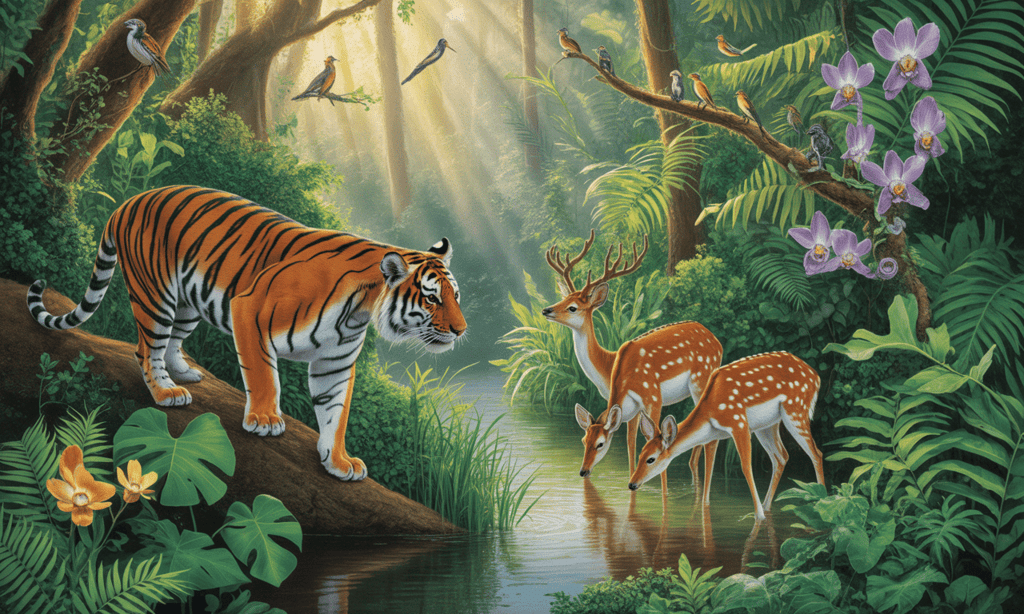 Let Us Take Three Examples from India:
Let Us Take Three Examples from India:
1. Gir Forest (Gujarat)
- Flora: Different types of large shady trees like teak, acacia, neem, and some wild bushes and grasses.
- Fauna: Animals like bears, dogs, cats, rats, rabbits, crows, kites, vultures, and the most special animal, the lion.
2. Jim Corbett National Park (Uttarakhand)
- Flora: A mix of pine trees, shrubs, and grasses thrives in the national park's varied climate.
- Fauna: The park is famous for its population of tigers, along with a variety of other animals, including leopards and elephants.
3. Jaladpara Sanctuary (West Bengal)
- Flora: Different types of trees like teak, bamboo, and grasses.
- Fauna: Different types of rhinos and bird species such as storks, pelicans and ducks.
Fauna of Forest Ecosystem
Fauna means all the animals that live in a forest ecosystem. Forests have many types of animals, depending on the weather and the types of plants growing there.
1. Tropical Rainforests such as those on the western coast of India and the northeast Himalayas:
- Flora: Evergreen trees, bamboos, ferns, and shrubs.
- Fauna: Jungle cats, leopards, monkeys, flying squirrels, snakes, centipedes, millipedes, many insects, snails, and more.
2. Temperate Deciduous Forests such as those found in North East America, Australia, Japan, Korea, North Eastern China, etc.
- Flora: Pine, oak, birch trees, and more.
- Fauna: Moths, beetles, deer, wolves, foxes, and more.
3. Coniferous Forests such as those found in North America, North Eurasia. These forests are found in the Himalayas at an altitude of 1700 to 3000 meters.
- Flora: Fir and pine trees.
- Fauna: Very few animals like squirrels, deer, goats, wolves, some birds like robins, and sparrows.
Food Chains
A food chain shows how food and energy move from one living thing to another in nature. It always starts with a green plant, which makes its own food using sunlight through a process called photosynthesis.
The green plant is eaten by a primary consumer, like a caterpillar. The caterpillar is then eaten by a secondary consumer, such as a small bird. That bird may be eaten by a tertiary consumer, like a hawk.
Each step in a food chain is called a trophic level:
The green plant is at Trophic Level I (producer).
The caterpillar is at Trophic Level II (primary consumer).
The small bird is at Trophic Level III (secondary consumer).
The hawk is at Trophic Level IV (tertiary consumer).
Some food chains also have a Trophic Level V, where a quaternary consumer, like an eagle, eats the hawk. This is the top carnivore in the chain.
Most food chains have 2 to 5 steps, but rarely go up to 6 or 7, because energy gets lost at each level.
Here are some examples of food chains with their trophic levels: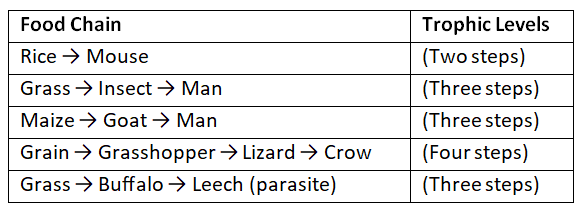
Food Webs
A food web is a network of many connected food chains. In a food web, one living thing can be part of several food chains.
For example, in a forest:
Plants (vegetation) can be eaten by a rat.
The rat can be eaten by a fox, an owl, or a stoat (a small animal like an otter).
The owl can eat the rat or a beetle (a small insect).
The beetle can eat plants or even the rat.
A rabbit can eat plants.
The fox can eat the rabbit or the stoat.
This shows how different food chains are linked together in a food web. Food webs are complex because many living things are connected in different ways. They help in the growth and balance of life in an ecosystem. Even small plants, which may seem unimportant, are a major food source for many animals.
In a forest, big trees have both:
Organic parts (living parts like leaves), and
Inorganic parts (non-living things like soil).
Plants and animals are linked in a food chain because they pass organic materials (like nutrients and energy) to one another. Plants take inorganic nutrients from the soil, but animals can't take them directly, so they eat plants to get those nutrients.
Advantages of Food Webs
- Food webs help living organisms survive better than simple food chains.
- In a food chain, if one food source is missing, organisms may find it hard to survive.
- But in a food web, there are many food options, so organisms can still find something to eat.
- This makes the ecosystem stronger and more stable.
Food Pyramids
- A food pyramid is a visual representation showing how energy or the number of living organisms is organised within an ecosystem.
- It looks like a triangle with different levels, starting wide at the bottom and getting narrower at the top.
In a food chain with a tiger at the top, the pyramid shows how energy moves:
Grass is eaten by deer, and deer are eaten by tigers.
Grass is at the bottom of the pyramid (the widest part), deer are in the middle, and tigers are at the top (the narrowest part).
There are two types of pyramids:
Pyramid of Numbers – This shows how many living things are at each level.
There are thousands of grass plants, hundreds of deer, and only a few tigers.
Pyramid of Biomass – This shows the total weight of living things at each level.
Grass has the highest total weight, deer have less, and tigers have the least.
The pyramid shape helps us understand that there is more energy, more living things, and more total weight at the bottom than at the top.
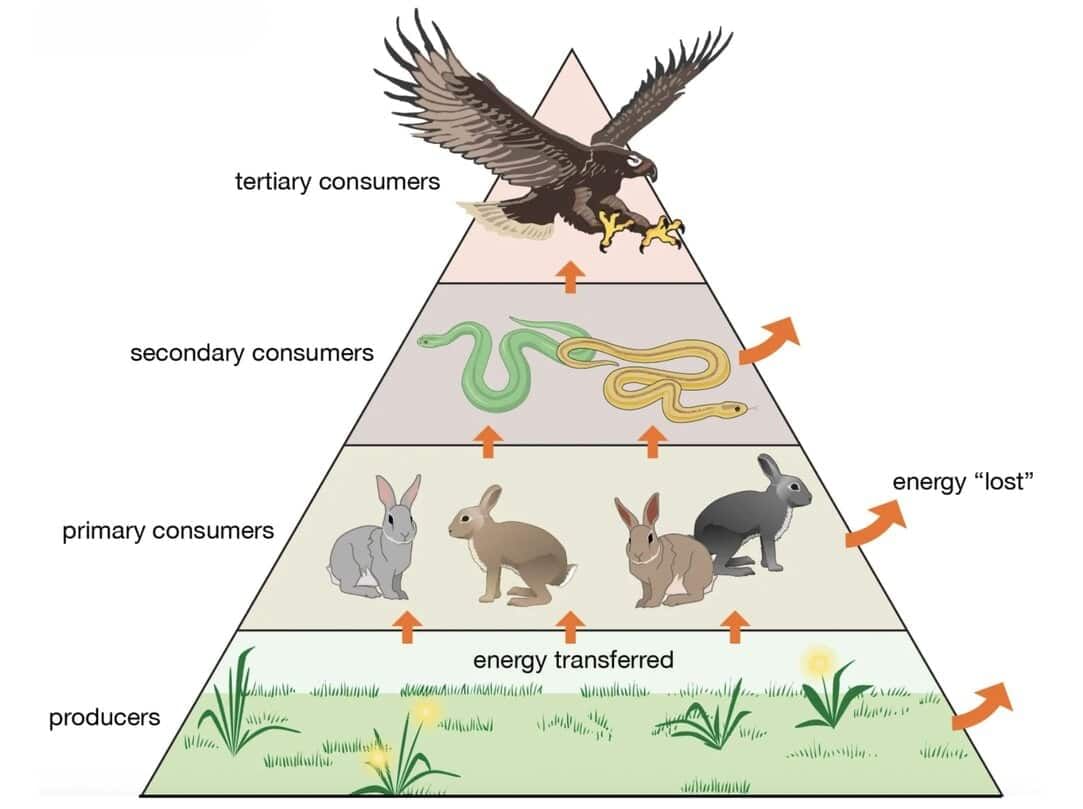
Interdependence Between Organisms
- Plants are the primary producers in an ecosystem. They make their food through a process called photosynthesis, using sunlight, water, and carbon dioxide. This food is the basis of the food chain, as animals eat plants for nourishment.
- Animals play a vital role in helping plants reproduce. They do this by spreading plant seeds and pollinating flowers, which is necessary for plants to produce fruits and new plants.
- Plants and animals also have a reciprocal relationship when it comes to gases. Plants give off oxygen, which animals need to breathe. In turn, animals exhale carbon dioxide, which plants need for photosynthesis.
- Decomposers, such as fungi and microorganisms, play a critical role in the ecosystem by breaking down dead plants and animals. This process is essential because it turns dead organic matter into nutrients that enrich the soil.
- Fungi, in particular, are important decomposers. They break down organic material, returning vital nutrients to the soil, which helps support the growth of new plants.
- Every organism in an ecosystem relies on others to perform various ecological functions, highlighting the interconnectedness and interdependence of all living things. This delicate balance is what keeps ecosystems healthy and thriving.
Symbiosis
- Symbiosis is when two different living things live together and help each other.
- There are three types of symbiosis: mutualism, commensalism, and parasitism.
- Mutualism is when both living things help each other and both benefit.
- For example, bees get nectar from flowers to make honey, and flowers get pollinated by bees to make seeds.
- Commensalism is when one living thing gets a benefit, and the other is neither harmed nor helped.
- For example, a small fish (remora) sticks to a shark and eats the shark’s leftover food, but the shark is not affected.
Parasitism
- Parasitism is a relationship where one organism, called the parasite, benefits at the expense of another, the host, who suffers harm. The parasite takes advantage by living in or on the host and getting food and shelter without giving anything in return.
- Parasites often have complex life cycles, sometimes involving one or more intermediate hosts.
- For example, the malaria-causing parasite Plasmodium requires an intermediate host — a mosquito — to spread to new hosts.
- Another example is the human liver fluke, a trematode parasite, which needs two intermediate hosts — a snail and a fish — to complete its life cycle.
- Parasites negatively affect the host by potentially lowering its ability to recover, grow, or reproduce.
Predation
- Predation occurs when one animal, known as the predator, hunts and consumes another animal, referred to as the prey.
- For example, when a tiger hunts and eats a deer, the tiger is the predator, and the deer is the prey.
- Predators are essential for maintaining the balance of ecosystems by controlling the populations of prey animals, preventing overpopulation.
Risks to the Ecosystem
- With growing industrialisation and scientific advancements, the natural resources and valuable environmental heritage that had been protected for generations are now rapidly declining.
- Disruption in the natural balance is putting ecosystems in serious danger. Human interference with nature has led to major global problems such as climate change, the spread of vector-borne diseases, declining wildlife and resources, and shortages of food and water.
- The overuse of natural resources worldwide has caused significant ecological damage, which poses the greatest threat to the effective functioning of ecosystems.
Need to Restore and Conserve the Ecosystems
- To bring ecosystems back to health, it's important to create a balance between living organisms and their surroundings. This is one of the most responsible actions we can take as humans. If immediate efforts aren't made to protect our deteriorating environment, the ecosystem will no longer support a healthy and sustainable life.
- We must respect nature’s balance and work to restore it. By conserving native resources like forests, rivers, and wildlife, we can help preserve the ecosystem. Major shifts in our thinking and behaviour are essential to saving these natural assets, which are the foundation of life itself.
|
75 videos|160 docs|52 tests
|
FAQs on Ecosystems Chapter Notes - Science for Grade 7
| 1. What are the main components of an ecosystem? |  |
| 2. How do food chains and food webs differ? |  |
| 3. What are the characteristics of a pond ecosystem? |  |
| 4. What types of flora are commonly found in a forest ecosystem? |  |
| 5. Why are food pyramids important in understanding ecosystems? |  |
















